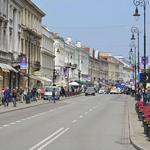Agnieszka & Robert
Things To Do
Warsaw Old Town
Like most cities with an "old town" this is a fun place to be. After this area was destroyed during WWII the local government agreed to rebuild the city as it was before the war, rather than modernize the style. Lots of outdoor dining & drinking options, shops and historical architecture. We spent 75% of our time in this area during our last visit.
Warsaw Uprising Museum
If you only visit one museum while visiting Poland, and you enjoy history, go to this one. It is fantastic.
The Royal Castle in Warsaw
Beautiful Castle that was restored after the war. This is where Polish royalty used to reside. During the tour you'll see the royal throne and many excellent art pieces including some that were "gifted" back to Poland from Germany.
Łazienki Palace
Łazienki Park is the largest park in Warsaw, Poland, occupying 76 hectares of the city center. The park-and-palace complex lies in Warsaw's central district (Śródmieście) on Ujazdów Avenue, which is part of the "Royal Route" linking the Royal Castle with Wilanów Palace to the south.
Wilanów Palace
Wilanów Palace or Wilanowski Palace (Polish: pałac w Wilanowie, Polish pronunciation: [ˈpawat͡s vvilaˈnɔvjɛ]) is a royal palace located in the Wilanów district, Warsaw. Wilanów Palace survived Poland's partitions and both World Wars, and so serves as a reminder of the culture of the Polish state as it was before the misfortunes of the 18th century. It is one of Poland's most important monuments. The Palace's museum, established in 1805, is a repository of the country's royal and artistic heritage. The palace and park in Wilanów hosts cultural events and concerts, including Summer Royal Concerts in the Rose Garden and the International Summer Early Music Academy. The palace, together with other elements of Warsaw Old Town, is one of Poland's official national Historic Monuments (Pomnik historii), as designated September 16, 1994. Its listing is maintained by the National Heritage Board of Poland.
Warsaw's Unknown Soldiers' Grave
The Tomb of the Unknown Soldier (Polish: Grób Nieznanego Żołnierza) is a monument in Warsaw, Poland, dedicated to the unknown soldiers who have given their lives for Poland. It is one of many such national tombs of unknowns that were erected after World War I, and the most important such monument in Poland.
Złote Tarasy
Shopping! With the USD to PLN exchange rates, you can buy lots of goodies (shoes, clothes etc) for a nice price :) One of the best malls in Warsaw - has everything!

Nowy Świat Street
Lots of great shopping. Ulica Nowy Świat is one of the main historic thoroughfares of Warsaw. It comprises part of the Royal Route that runs from Warsaw's Royal Castle and Old Town, south to King John III Sobieski's 17th-century royal residence at Wilanów.
Palace of Culture and Science
Come see the gift from the Soviet Union to Poland. Looks very Russian, because it came from them. You can go up an elevator to a top view deck which give you an awesome panorama of the city.
Warszawa Zoo
ZOO! For the littles, and the older people too. The Warsaw Zoological Garden, known simply as the Warsaw Zoo (Polish: Warszawskie Zoo), is a scientific zoo located alongside the Vistula River in Warsaw, Poland.[6] The zoo covers about 40 hectares (99 acres) in central Warsaw, and sees around 1,000,000 visitors annually, making it one of the busiest zoos in Europe. It is home to over 4,200 animals representing more than 500 species
Panorama Sky Bar
Drinks with a view!
Vitkac
Fancy shopping
Oberża Pod Czerwonym Wieprzem
Oberża Pod Czerwonym Wieprzem is situated in a historically preserved realist pavilion of the type. The building was given to the city of Warsaw at the end of the 60s and beginning of the 70s by Erich Honecker, leader of the German Democratic Republic. Fans of PRL's cuisine (The Polish People's Republic) might associate him with the popular milk bar restaurant. The theme of the restaurant is connected with the stormy, yet very interesting history of its location. The Oberża Pod Czerwonym Wieprzem is situated on the border between today's town centre and the Wola district, place where, in those times all the Warsaw factories and breweries could be found. It is here that, within the working class, the first Polish communist/socialist movement was born.

Muzeum Katyńskie
The Museum has recently been relocated to the impressive Citadel and the permanent collection can now be viewed in appropriately grand and stoic surroundings. The museum documents the shocking events of 1940 when around 20,000 Polish officers were executed by their Soviet captors in the middle of a Russian forest. The museum has a host of objects, documents and personal effects that have been recovered from the site near Smoleńsk, Russia. The artefacts from the victims and a scrolling list of the victim’s names needs no explanation and the multimedia presentation of the extenuating circumstances, the victim's stories and historical relevancy are well thought out and it's worth exploring the whole museum. Despite this, there are, however, audio guides available for 10zł.
Warsaw Ghetto Wall
Boska Praga
Restaurant near the the ArtHotel
La Playa Music Bar
Beach Bar
Restauracja Szynk Praski
Casual cozy restaurant/pub block away from the hotel
ARTHOTEL STALOWA 52
Wedding Venue